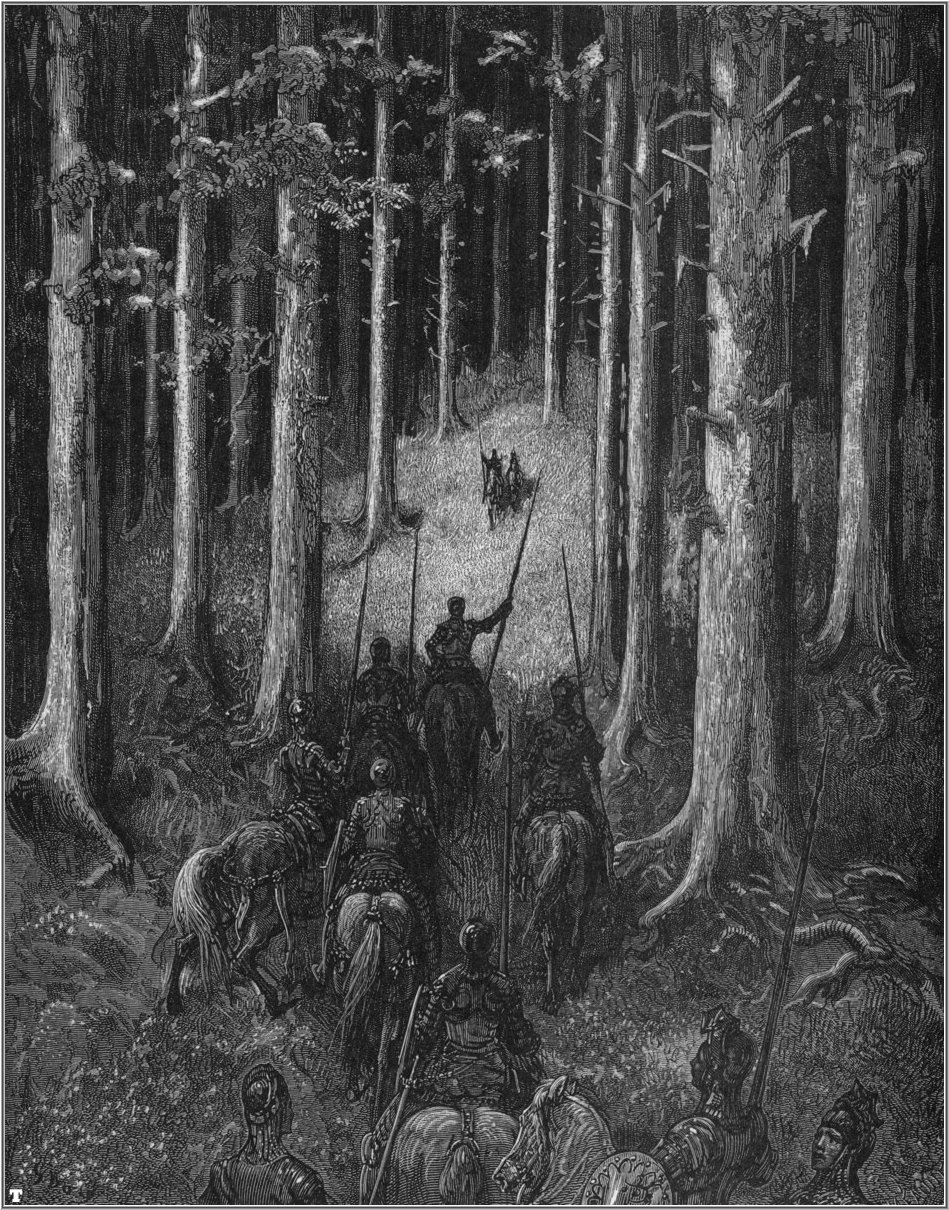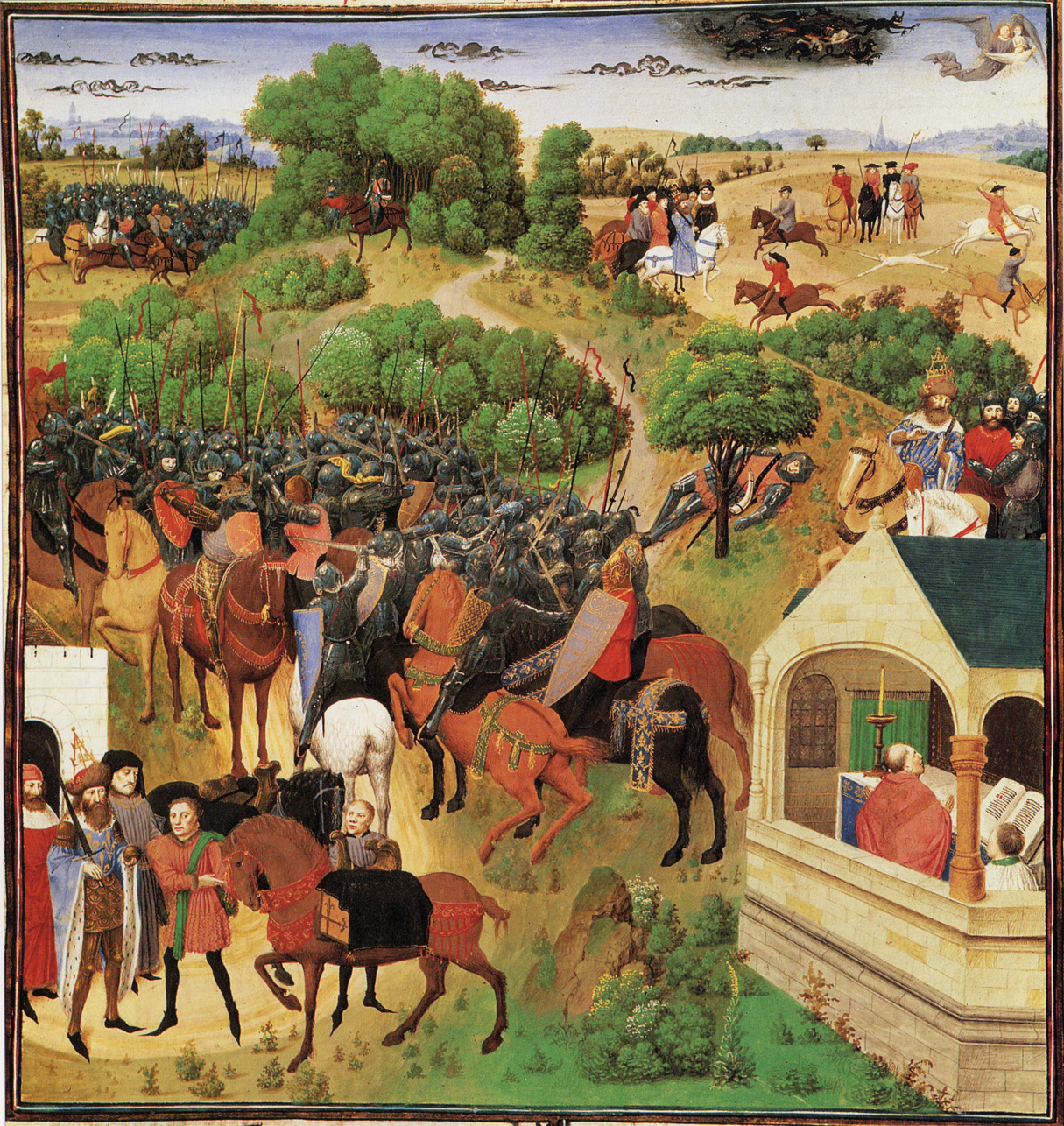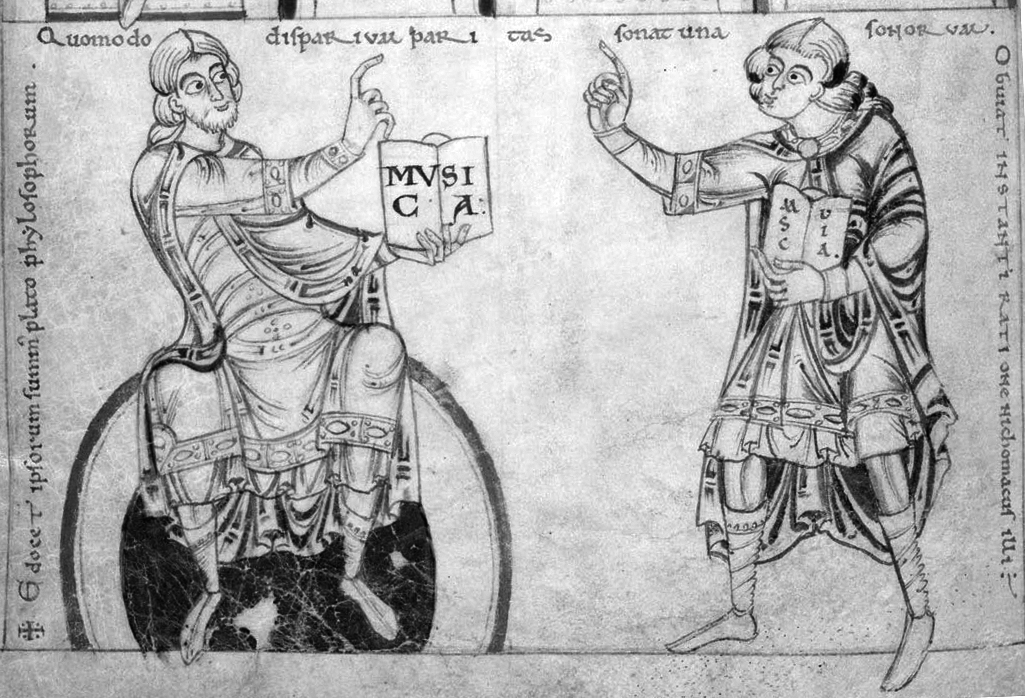|
Johannes De Grocheo
Johannes de Grocheio (or Grocheo) (Ecclesiastical Latin: ɔˈan.nɛs dɛ ɡrɔˈkɛj.jɔ c. 1255 – c. 1320) was a Parisian musical theorist of the early 14th century. His French name was Jean de Grouchy, but he is best known by his Latinized name. He was the author of the treatise ''Ars musicae'' ("The Art of Music") (c. 1300), which describes the functions of sacred and secular music in and around Paris during his lifetime. Biography Johannes de Grocheio, originally named Jean de Grouchy, likely grew up in a wealthy family that controlled a fiefdom in Normandy. Grocheio studied music and philosophy in Paris, but there is no evidence that he received a degree. Despite the lack of such evidence, he is credited as ''magister'' (master) and ''regens Parisius'' (resident teacher in Paris in the Darmstadt manuscript, although the latter title was added to the manuscript after it was copied. Grocheio may also have taught at the Basilica of St. Denis based on the plainsong he desc ... [...More Info...] [...Related Items...] OR: [Wikipedia] [Google] [Baidu] |
Ecclesiastical Latin
Latin, also called Church Latin or Liturgical Latin, is a form of Latin developed to discuss Christian thought in Late Antiquity and used in Christian liturgy, theology, and church administration down to the present day, especially in the Catholic Church. It includes words from Vulgar Latin and Classical Latin (as well as Greek and Hebrew) re-purposed with Christian meaning. It is less stylized and rigid in form than Classical Latin, sharing vocabulary, forms, and syntax, while at the same time incorporating informal elements which had always been with the language but which were excluded by the literary authors of Classical Latin. Its pronunciation was partly standardized in the late 8th century during the Carolingian Renaissance as part of Charlemagne's educational reforms, and this new letter-by-letter pronunciation, used in France and England, was adopted in Iberia and Italy a couple of centuries afterwards. As time passed, pronunciation diverged depending on the local verna ... [...More Info...] [...Related Items...] OR: [Wikipedia] [Google] [Baidu] |
Aristotle
Aristotle (; grc-gre, Ἀριστοτέλης ''Aristotélēs'', ; 384–322 BC) was a Greek philosopher and polymath during the Classical period in Ancient Greece. Taught by Plato, he was the founder of the Peripatetic school of philosophy within the Lyceum and the wider Aristotelian tradition. His writings cover many subjects including physics, biology, zoology, metaphysics, logic, ethics, aesthetics, poetry, theatre, music, rhetoric, psychology, linguistics, economics, politics, meteorology, geology, and government. Aristotle provided a complex synthesis of the various philosophies existing prior to him. It was above all from his teachings that the West inherited its intellectual lexicon, as well as problems and methods of inquiry. As a result, his philosophy has exerted a unique influence on almost every form of knowledge in the West and it continues to be a subject of contemporary philosophical discussion. Little is known about his life. Aristotle was born in th ... [...More Info...] [...Related Items...] OR: [Wikipedia] [Google] [Baidu] |
Estampie
The estampie (french: estampie, Occitan and ca, estampida, it, istanpitta) is a medieval dance and musical form which was a popular instrumental and vocal form in the 13th and 14th centuries. The name was also applied to poetry. Musical form The estampie is similar in form to the lai, consisting of a succession of repeated notes. According to Johannes de Grocheio, there were both vocal and instrumental estampies (for which he used the Latin calque "stantipes"), which differed somewhat in form. Grocheio calls the sections in both the French vocal and instrumental estampie ''puncta'' (singular ''punctus''), Each ''puncta'' has a pair of lines that repeat the same melody, in the form: :''aa, bb, cc, etc.''. The two statements of the melody in each punctus differ only in their endings, described as ''apertum'' ("open") and ''clausum'' ("closed") by Grocheio, who believed that six ''puncta'' were standard for the stantipes (his term for the estampie), though he was aware of stan ... [...More Info...] [...Related Items...] OR: [Wikipedia] [Google] [Baidu] |
Rondeau (forme Fixe)
A ''rondeau'' (; plural: ''rondeaux'') is a form of medieval and Renaissance French poetry, as well as the corresponding musical chanson form. Together with the ballade and the virelai it was considered one of the three ''formes fixes'', and one of the verse forms in France most commonly set to music between the late 13th and the 15th centuries. It is structured around a fixed pattern of repetition of material involving a refrain. The rondeau is believed to have originated in dance songs involving alternating singing of the refrain elements by a group and of the other lines by a soloist. The term "Rondeau" is today used both in a wider sense, covering several older variants of the form – which are sometimes distinguished as the triolet and rondel – and in a narrower sense referring to a 15-line variant which developed from these forms in the 15th and 16th centuries. The rondeau is unrelated with the much later instrumental dance form that shares the same name in French baroqu ... [...More Info...] [...Related Items...] OR: [Wikipedia] [Google] [Baidu] |
Renaud De Montauban
Renaud de Montauban (; also spelled ''Renaut'', ''Renault'', Italian: ''Rinaldo di Montalbano'', Dutch: ''Reinout van Montalba(e)n'') was a legendary hero and knight which appeared in a 12th-century Old French ''chanson de geste'' known as ''The Four Sons of Aymon''. The four sons of Duke Aymon are Renaud, Richard, Alard and Guiscard, and their cousin is the magician Maugris (French: ''Maugis'', Italian: ''Malagi'', ''Malagigi''). Renaud possesses the magical horse Bayard and the sword Froberge (Italian: ''Fusberta'', ''Frusberta'', French: ''Flamberge''). The story of Renaud was popular across Europe. The tale was adapted into Dutch, German, Italian and English versions throughout the Middle Ages, inspired the Old Icelandic '' Mágus saga jarls'', and also incited subsequent sequels and related texts that form part of the Doon de Mayence cycle of ''chansons''. Renaud, as Rinaldo, is an important character in Italian Renaissance epics, including ''Morgante'' by Luigi Pulci, ''Orl ... [...More Info...] [...Related Items...] OR: [Wikipedia] [Google] [Baidu] |
Doon De Mayence
Doon de Mayence also known as Doolin de Maience, Doon de Maience or Doolin de Mayence was a fictional hero of the Old French ''chansons de geste'', who gives his name to the third cycle of the Charlemagne romances dealing with the feudal revolts. There is no single unifying theme in the ''geste'' of Doon de Mayence. The rebellious barons are connected by the poets with Doon by fictitious genealogical ties and all are represented as opposing Charlemagne, although their adventures—insofar as they possess a historical basis—generally occur before (or after) his reign. The general insolence of their attitude to the sovereign suggests that Charlemagne is here only a pseudonym for his weaker successors. The tradition of a traitorous family of Mayence (Mainz), which was developed in Italy into a series of stories about criminals, appeared later than the Carolingian cycle. A contributor to the Chronicle of Fredegar states (iv. 87) that the army of Sigebert was betrayed from withi ... [...More Info...] [...Related Items...] OR: [Wikipedia] [Google] [Baidu] |
Charlemagne
Charlemagne ( , ) or Charles the Great ( la, Carolus Magnus; german: Karl der Große; 2 April 747 – 28 January 814), a member of the Carolingian dynasty, was King of the Franks from 768, King of the Lombards from 774, and the first Holy Roman Emperor, Emperor of the Romans from 800. Charlemagne succeeded in uniting the majority of Western Europe, western and central Europe and was the first recognized emperor to rule from western Europe after the fall of the Western Roman Empire around three centuries earlier. The expanded Frankish state that Charlemagne founded was the Carolingian Empire. He was Canonization, canonized by Antipope Paschal III—an act later treated as invalid—and he is now regarded by some as Beatification, beatified (which is a step on the path to sainthood) in the Catholic Church. Charlemagne was the eldest son of Pepin the Short and Bertrada of Laon. He was born before their Marriage in the Catholic Church, canonical marriage. He became king of the ... [...More Info...] [...Related Items...] OR: [Wikipedia] [Google] [Baidu] |
Chanson De Geste
The ''chanson de geste'' (, from Latin 'deeds, actions accomplished') is a medieval narrative, a type of epic poem that appears at the dawn of French literature. The earliest known poems of this genre date from the late 11th and early 12th centuries, shortly before the emergence of the lyric poetry of the troubadours and trouvères, and the earliest verse romances. They reached their highest point of acceptance in the period 1150–1250.Hasenohr, 242. Composed in verse, these narrative poems of moderate length (averaging 4000 lines) were originally sung, or (later) recited, by minstrels or jongleurs. More than one hundred ''chansons de geste'' have survived in approximately three hundred manuscripts''La Chanson de Roland,'' 12. that date from the 12th to the 15th century. Origins Since the 19th century, much critical debate has centered on the origins of the ''chansons de geste'', and particularly on explaining the length of time between the composition of the ''chansons'' a ... [...More Info...] [...Related Items...] OR: [Wikipedia] [Google] [Baidu] |
Lessay Abbey
, image=LessayAbbaye3.JPG , caption=Lessay Abbey, 2008 , pushpin map=France , coordinates= , location=Lessay, Manche, Normandy , country=France , denomination=Roman Catholic , website= , religious order=Benedictines , parish=Sainte-Opportune , diocese=Coutances , embedded= The Abbey of the Holy Trinity (french: Abbaye de la Sainte-Trinité) is an 11th century Romanesque Benedictine Abbey church located in Lessay, Manche, France, then in Normandy. The abbey is one of the most important Norman Romanesque churches, and, along with Durham Cathedral, one of the first examples use of the rib vault to cover the choir in about 1098. This element became a key feature of Gothic architecture. The abbey was nearly destroyed in 1357. It was destroyed in 1944 and subsequently rebuilt. History The Benedictine Abbey of the Holy Trinity in Lessay was founded in 1056 by , Baron of La Haye-du-Puits, and his wife Emma,Tome 11 of the ''Gallia Christiana'', p. 917 who deeded all their holdings in t ... [...More Info...] [...Related Items...] OR: [Wikipedia] [Google] [Baidu] |
Nicomachus
Nicomachus of Gerasa ( grc-gre, Νικόμαχος; c. 60 – c. 120 AD) was an important ancient mathematician and music theorist, best known for his works ''Introduction to Arithmetic'' and ''Manual of Harmonics'' in Greek. He was born in Gerasa, in the Roman province of Syria (now Jerash, Jordan). He was a Neopythagorean, who wrote about the mystical properties of numbers.Eric Temple Bell (1940), ''The development of mathematics'', page 83.Frank J. Swetz (2013), ''The European Mathematical Awakening'', page 17, Courier Life Little is known about the life of Nicomachus except that he was a Pythagorean who came from Gerasa.} Historians consider him a Neopythagorean based on his tendency to view numbers as having mystical properties. The age in which he lived (c. 100 AD) is only known because he mentions Thrasyllus in his ''Manual of Harmonics'', and because his ''Introduction to Arithmetic'' was apparently translated into Latin in the mid 2nd century by Apuleius.Henrietta ... [...More Info...] [...Related Items...] OR: [Wikipedia] [Google] [Baidu] |
Franco Of Cologne
Franco of Cologne (; also Franco of Paris) was a German music theorist and possibly a composer. He was one of the most influential theorists of the Late Middle Ages, and was the first to propose an idea which was to transform musical notation permanently: that the duration of any note should be determined by its appearance on the page, and not from context alone. The result was Franconian notation, described most famously in his ''Ars cantus mensurabilis''. Life Some details are known about his life, and more can be inferred. In his own treatise he described himself as the papal chaplain and the preceptor of the Knights Hospitallers of St. John at Cologne, an extremely powerful position in northern Europe in the 13th century. Other documents of the time refer to him as "Franco of Paris" as well as "Franco teutonicus"; since his writing on music is intimately associated with the Notre Dame school of Paris, and his Teutonic origin is mentioned in several sources, he was probably ... [...More Info...] [...Related Items...] OR: [Wikipedia] [Google] [Baidu] |
Johannes De Garlandia (music Theorist)
Johannes de Garlandia (Johannes Gallicus) (fl. c. 1270 – 1320) was a French music theorist of the late ''ars antiqua'' period of medieval music. He is known for his work on the first treatise to explore the practice of musical notation of rhythm, ''De Mensurabili Musica''. Life and problems of identification Until the mid-1980s it was believed that Johannes de Garlandia lived in the first half of the 13th century and wrote two treatises, ''De Mensurabili Musica'' and ''De plana musica'', and thus was intimately connected with the composers of the Notre Dame school, at least one of whom — Pérotin — may still have been alive in the earlier part of his career. Unfortunately the linking of his name with those two works only began after 1270, and it now seems likely that Garlandia was one Jehan de Garlandia, a keeper of a bookshop in Paris, records of whom appear on various official Parisian documents between 1296 and 1319. Most likely he was an editor of the two ... [...More Info...] [...Related Items...] OR: [Wikipedia] [Google] [Baidu] |




